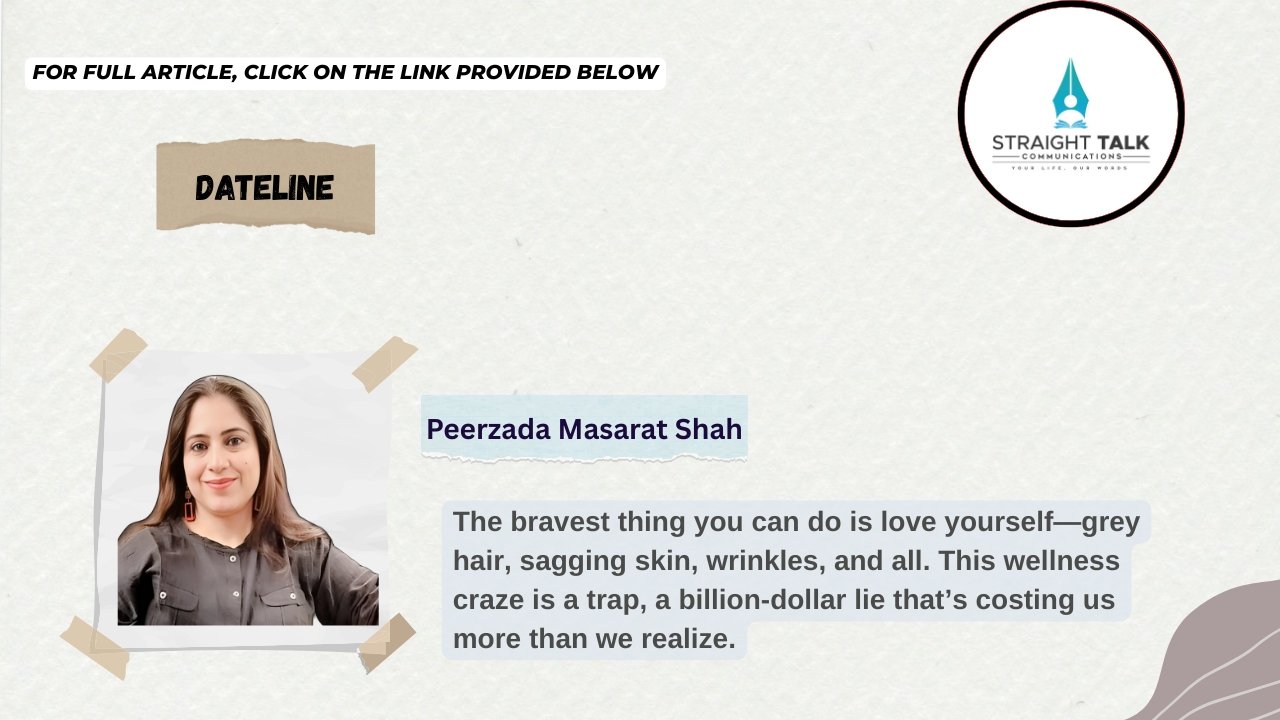Shefali Jariwala’s Death at 42: A Wake-Up Call to End the Toxic Wellness Trap

The bravest thing you can do is love yourself—grey hair, sagging skin, wrinkles, and all. This wellness craze is a trap, a billion-dollar lie that’s costing us more than we realize.
Peerzada Masarat Shah
Shefali Jariwala, the vibrant “Kaanta Laga” girl who danced her way into our hearts, is gone at just 42. Her sudden passing feels like a punch to the gut, a stark reminder of how we’re all caught in this relentless chase to stay young, fit, and flawless. In a world where wrinkles are treated like tragedies and grey hair like a personal failure, her death should make us stop and think—but will it? Probably not. We’re too deep in this obsession with eternal youth, drowning in Botox, protein shakes, and promises of a body that defies time.
We’ve turned aging into the enemy, something to be fought with every cream, injection, or “miracle” supplement we can get our hands on. It’s not just about looking good anymore—it’s a full-blown fixation. Influencers with perfect filters, gym trainers playing doctor, and self-proclaimed wellness gurus push this idea that we can outrun time itself. They sell us the glow of youth, but nobody talks about the price we’re paying. The dream of staying 25 forever is everywhere—on billboards, in ads, in the feeds we scroll through late at night. But when someone like Shefali, young and full of life, collapses, it forces us to ask: Is this dream worth dying for?
Gyms used to be places to get strong, to feel alive. Now, they’re like secret backrooms for questionable “health” fixes. You walk in for a workout, and before you know it, someone’s handing you a protein shake laced with who-knows-what, a testosterone booster, or some sketchy shot that’s supposed to melt fat and turn back the clock. Trainers, often with no medical training, act like experts, promising six-pack abs or a body like a movie star in weeks. “It’s safe, don’t worry, it’s all natural!” they say, tossing around words like “peptides” or “Clenbuterol” like they’re handing out candy. But your body might not agree. Your heart, your liver—they’re not signing up for this experiment. The side effects? Nobody talks about those until it’s too late.
Then there are the clinics, popping up on every corner like coffee shops, with signs screaming that age is just a number you can erase. Dermatologists, plastic surgeons, and Instagram-famous “experts” push Botox like it’s a quick fix, along with chemical peels, laser treatments, and vampire facials that sound like they belong in a sci-fi movie. They don’t tell you how these treatments can mess with your hormones, strain your heart, or quietly raise the risk of something far worse than a few laugh lines. It’s a gamble, and we’re not even asking what we’re betting. The rules around these drugs and treatments are barely enforced. Unapproved creams, powders, and injectables flood the market, slipping through the cracks while regulatory authorities look the other way. We’re all guinea pigs in a giant, glossy beauty experiment, and nobody’s checking if the lab is safe.
The truth hits harder when you see the headlines: more and more people in their 30s and 40s are collapsing. On dance floors, in gyms, mid-jog, or even while sipping their keto smoothies. Doctors might call it “sudden cardiac arrest” or point to some undiagnosed condition, but we can’t ignore the patterns. We’re overloading ourselves—piling on stress, steroids, supplements, and this endless pressure to look perfect. Shefali’s story is still unfolding, and we may never get the full truth about what happened. But her death raises questions we can’t keep dodging. Are these “lifestyle” drugs as safe as we’re told? Is chasing a youthful glow worth risking your life? Are we setting ourselves up to burn out while trying to shine?
There was a time when growing older was something to embrace. Grey hair meant wisdom earned through years of living. Wrinkles were stories etched into your face—proof of laughter, tears, and everything in between. Now, we hide them like they’re flaws, ashamed of the natural process of being human. Aging isn’t a disease; it’s a gift, a chance to evolve, to grow deeper, to live with authenticity. It’s not about fighting time but moving through it with grace. Real health isn’t found in a needle or a pill bottle. It’s in the simple things: eating real food, staying active, sleeping well, laughing with friends, finding peace in your own skin. Those are the timeless ways to stay vibrant, not some collagen shot or hormone therapy that promises more than it delivers.
So, what do we do? We need to demand better. Governments and health authorities, like the Drug Controller General of India, need to wake up and crack down on unapproved supplements and gym “pharmacies” pushing dangerous fixes. Schools and communities should teach kids that health is about feeling good, not chasing a filtered ideal. As a society, we need to shift our focus—stop worshipping youth and start celebrating wisdom, character, and the beauty of a life well-lived. We need to call out the fake doctors, the unlicensed “experts,” and the quacks turning fitness into something fatal. And the media—news channels, influencers, magazines—needs to stop peddling miracle cures and start showing real people aging with pride, not shame.
In a world that glorifies smooth skin and sculpted bodies, the bravest thing you can do is love yourself—grey hair, sagging skin, wrinkles, and all. This wellness craze is a trap, a billion-dollar lie that’s costing us more than we realize. Shefali Jariwala’s death is a heartbreaking wake-up call, a reminder that life is fragile and fleeting. We need to choose to live fully, not just look like we’re living. Because no amount of Botox can heal a heart that’s stopped beating, and no protein shake can bring back the spark of a life cut short. Let’s stop chasing an impossible dream and start embracing the one we’re already living. That’s the real way to honor those we’ve lost—and to keep ourselves alive.







